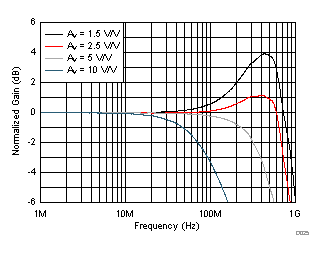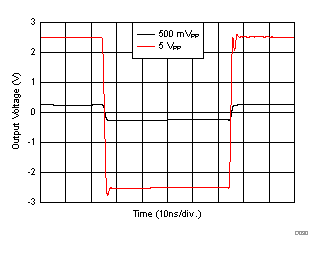at +VCC = 6.0 V, –VCC = –6.0 V, 25-Ω D2S source impedance, VREF = GND, RF = 249 Ω, RG = 162 Ω, OPS AV = 2.5V/V, OPS RLOAD = 100 Ω at pin 11, OPS enabled (DISABLE = GND), external input path selected (PATHSEL = +VCC), and TJ ≈ 25°C (unless otherwise noted)

| VOUT = 100 mVPP, see Table 8-1 for RF values vs gain |
 Figure 6-27 Noninverting Response vs Output Voltage
Figure 6-27 Noninverting Response vs Output Voltage Figure 6-29 Noninverting Step Response
Figure 6-29 Noninverting Step Response Figure 6-31 HD2 vs Output Voltage
Figure 6-31 HD2 vs Output Voltage Figure 6-33 HD2 vs Load Resistance
Figure 6-33 HD2 vs Load Resistance Figure 6-35 HD2 vs Supply Voltage
Figure 6-35 HD2 vs Supply Voltage
| ±100-kHz tone separation, output voltage for each tone |
 Figure 6-39 Input-Referred Spot Noise vs Frequency
Figure 6-39 Input-Referred Spot Noise vs Frequency Figure 6-41 Quiescent Supply Current vs Temperature
Figure 6-41 Quiescent Supply Current vs Temperature Figure 6-43 Series Output Resistance vs Load Capacitance
Figure 6-43 Series Output Resistance vs Load Capacitance
| ±VCC = ±7.5 V, RF = 158 Ω,
AV = 5 V/V, VOUT = 10
VPP, see Figure 6-43 for RS value |
Figure 6-45 HD2
vs Load Capacitance
| ±VCC = ±7.5 V, CLOAD = 100
pF, RF = 158 Ω, AV = 5 V/V, see
Figure 6-43 for RS value |
Figure 6-47 Pulse
Response
| VOUT = 100 mVPP, see Table 8-3 for RF values vs gain |
 Figure 6-28 Inverting Response vs Output Voltage
Figure 6-28 Inverting Response vs Output Voltage Figure 6-30 Inverting Step Response
Figure 6-30 Inverting Step Response Figure 6-32 HD3 vs Output Voltage
Figure 6-32 HD3 vs Output Voltage Figure 6-34 HD3 vs Load Resistance
Figure 6-34 HD3 vs Load Resistance Figure 6-36 HD3 vs Supply Voltage
Figure 6-36 HD3 vs Supply Voltage
| ±100-kHz tone separation, output voltage for each tone |

| Output swing with better than 0.1% linearity |

| ±4.5-V input triangular wave, OPS AV = –2.5 V/V |
 Figure 6-44 Frequency Response vs Load Capacitance
Figure 6-44 Frequency Response vs Load Capacitance
| ±VCC = ±7.5 V, RF = 158 Ω,
AV = 5 V/V, VOUT = 10
VPP, see Figure 6-43 for RS value |
Figure 6-46 HD3
vs Load Capacitance
| ±VCC = ±7.5 V, CLOAD = 150
pF, RF = 158 Ω, AV = 5 V/V, see
Figure 6-43 for RS value. |
Figure 6-48 Pulse
Response
 Figure 6-27 Noninverting Response vs Output Voltage
Figure 6-27 Noninverting Response vs Output Voltage Figure 6-29 Noninverting Step Response
Figure 6-29 Noninverting Step Response Figure 6-31 HD2 vs Output Voltage
Figure 6-31 HD2 vs Output Voltage


 Figure 6-39 Input-Referred Spot Noise vs Frequency
Figure 6-39 Input-Referred Spot Noise vs Frequency



 Figure 6-32 HD3 vs Output Voltage
Figure 6-32 HD3 vs Output Voltage









